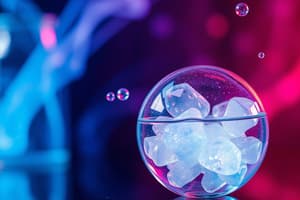Podcast
Questions and Answers
What effect does an increase in temperature have on the volume of gas at constant pressure according to Charles's Law?
What effect does an increase in temperature have on the volume of gas at constant pressure according to Charles's Law?
- The volume increases. (correct)
- The volume decreases.
- The volume fluctuates unpredictably.
- The volume remains unchanged.
Which of the following best describes the relationship between work, force, and distance?
Which of the following best describes the relationship between work, force, and distance?
- Work is the product of force and distance in the direction of the force. (correct)
- Work is equal to force divided by distance.
- Work increases as distance decreases.
- Work is independent of both force and distance.
If two trains travel at a constant speed of 80 km/h, which train has the greatest kinetic energy based on their masses?
If two trains travel at a constant speed of 80 km/h, which train has the greatest kinetic energy based on their masses?
- The kinetic energy cannot be determined without additional information.
- Train B with a mass of 295 kg.
- Train A with a mass of 300 kg. (correct)
- Both trains have equal kinetic energy.
In the scenario where Rivan exerts a 13 N force over 16 meters and Yasin exerts a 17 N force over 19 meters, which situation entails more work being done?
In the scenario where Rivan exerts a 13 N force over 16 meters and Yasin exerts a 17 N force over 19 meters, which situation entails more work being done?
What are the units of measurement for work in the context of physics?
What are the units of measurement for work in the context of physics?
What is a key characteristic that differentiates homogeneous mixtures from heterogeneous mixtures?
What is a key characteristic that differentiates homogeneous mixtures from heterogeneous mixtures?
Which of the following accurately defines a pure substance?
Which of the following accurately defines a pure substance?
What is the primary measurement unit used for the volume of irregular solids?
What is the primary measurement unit used for the volume of irregular solids?
Which change represents a physical change rather than a chemical change?
Which change represents a physical change rather than a chemical change?
In which states of matter do particles typically have the most kinetic energy?
In which states of matter do particles typically have the most kinetic energy?
What happens to the particles of a gas when thermal energy is decreased?
What happens to the particles of a gas when thermal energy is decreased?
What is the main factor that affects a change of state in matter?
What is the main factor that affects a change of state in matter?
Which gas law states that pressure and volume are inversely related when temperature remains constant?
Which gas law states that pressure and volume are inversely related when temperature remains constant?
What is the basic unit of matter?
What is the basic unit of matter?
Which of the following describes a property of pure substances?
Which of the following describes a property of pure substances?
What is the formula for calculating density?
What is the formula for calculating density?
Which of the following is an example of a physical change?
Which of the following is an example of a physical change?
How do mass and weight primarily differ?
How do mass and weight primarily differ?
What properties can distinguish between physical and chemical changes?
What properties can distinguish between physical and chemical changes?
Which of the following options represents a mixture?
Which of the following options represents a mixture?
Which option best describes an element?
Which option best describes an element?
Flashcards
Kinetic Energy
Kinetic Energy
The energy of motion. It depends on an object's mass and speed.
Potential Energy
Potential Energy
Stored energy due to an object's position or state. It can be converted into kinetic energy.
Energy
Energy
The ability to do work.
Work
Work
Signup and view all the flashcards
Power
Power
Signup and view all the flashcards
Homogeneous Mixture
Homogeneous Mixture
Signup and view all the flashcards
Heterogeneous Mixture
Heterogeneous Mixture
Signup and view all the flashcards
What is matter?
What is matter?
Signup and view all the flashcards
Pure Substance
Pure Substance
Signup and view all the flashcards
Physical Change
Physical Change
Signup and view all the flashcards
Chemical Change
Chemical Change
Signup and view all the flashcards
Volume
Volume
Signup and view all the flashcards
Mass
Mass
Signup and view all the flashcards
What are the basic building blocks of matter?
What are the basic building blocks of matter?
Signup and view all the flashcards
What are the components that make up matter?
What are the components that make up matter?
Signup and view all the flashcards
What is the basic unit of matter?
What is the basic unit of matter?
Signup and view all the flashcards
What are physical properties of matter?
What are physical properties of matter?
Signup and view all the flashcards
What are chemical properties of matter?
What are chemical properties of matter?
Signup and view all the flashcards
What is a pure substance?
What is a pure substance?
Signup and view all the flashcards
What is a mixture?
What is a mixture?
Signup and view all the flashcards
What is a physical change?
What is a physical change?
Signup and view all the flashcards
What is a chemical change?
What is a chemical change?
Signup and view all the flashcards
Study Notes
6th Grade Science Study Guide - Semester 1 Exam
-
Review Week: January 12-16, 2025
-
Clarification on Study Guide: Examples in the study guide are designed to aid understanding, but exam questions may differ.
-
Exam Goal: Assess comprehension and application of concepts, not just memorization.
Topic 1: Introduction to Matter
-
Standard: MS-PS1-1. Develop models to describe the atomic composition of simple molecules and extended structures.
-
Lesson 1: Describing and Classifying Matter (Google Classroom, Week 2)
- Key Concepts: Matter is composed of atoms, elements, molecules, and compounds.
-
Lesson 2: Measuring Matter (Google Classroom, Weeks 4-6)
- Key Concepts:
- Identifying the basic unit of matter.
- Understanding chemical and physical properties of matter.
- Differentiating between pure substances and mixtures.
- Identifying properties of physical and chemical changes.
- Identifying different properties of matter (mass, weight).
- Calculating volume (regular and irregular solids).
- Calculating density (using formula P=M/V).
- Key Concepts:
-
Lesson 3: Changes in Matter (Google Classroom, Week 6)
- Key Concepts:
- Differentiating between physical and chemical changes.
- Analyzing and interpreting scenarios to determine if a change is physical or chemical.
- Key Concepts:
Topic 2: Solid, Liquid, and Gas
-
Standard: MS-PS1-4: Develop a model that predicts and describes changes in particle motion, temperature, and state of a pure substance when thermal energy is added or removed.
-
Lesson 1: States of Matter (Google Classroom, Weeks 7-8)
- Key Concepts:
- Explaining similarities and differences between solids, liquids, and gases.
- Demonstrating how particle arrangement and movement differ in each state.
- Relating particle motion to the state of matter.
- Key Concepts:
-
Lesson 2: Changes of State (Google Classroom, Week 9)
- Key Concepts:
- Describing particle behavior during state changes (solid, liquid, gas).
- Identifying factors affecting state changes.
- Explaining particle behavior as thermal energy changes.
- Key Concepts:
-
Lesson 3: Gas Behavior (Google Classroom, Week 10)
- Key Concepts:
- Understanding Boyle's, Charles', and Lussac's gas laws.
- Relating pressure and volume of gases.
- Understanding concepts of inversely and directly proportional relationships.
- Demonstrating gas law relationships (e.g., hot air balloon).
- Key Concepts:
Topic 3: Energy
-
Standard: MS-PS3-1
-
Lesson 1: Energy, Motion, Force, and Work (Google Classroom, Weeks 10-11)
- Key Concepts:
- Defining energy, motion, force, and work.
- Relating these concepts to each other.
- Calculating work.
- Key Concepts:
-
Lesson 2: Kinetic and Potential Energy (Google Classroom, Weeks 13-14)
- Key Concepts:
- Defining kinetic and potential energy.
- Describing factors that affect kinetic and potential energy.
- Calculating kinetic and potential energy.
- Key Concepts:
Studying That Suits You
Use AI to generate personalized quizzes and flashcards to suit your learning preferences.


